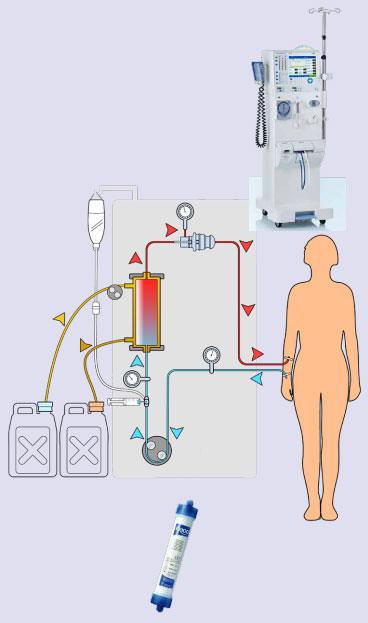
WHY DIALYSIS
WHY DIALYSIS
Kidneys. These are two bean-shaped organs located just below the rib cage, one on each side of our spine. They are among the most vital organs of the human body. The primary function of the kidney is to filter and purify the blood (about half a cup of blood every minute). Each kidney removes waste materials (as well as extra water and other chemicals not required by the body), which are then flushed out of the body in the form of urine.
Kidney failure is the condition where there is a significant reduction in the ability of the kidneys to filter and excrete waste products from the body.
Chronic kidney disease (CKD) is the gradual, progressive and irreversible loss of kidney function over several months to years. The kidney
function decreases continuously, and eventually reaches a stage where the kidneys stop working altogether. CKD is a ‘silent disease’, and often
goes unnoticed. Common symptoms may include generalized weakness, loss of appetite, nausea and vomiting, generalized swelling, high
blood pressure, etc. Two important and common causes of CKD are diabetes and hypertension.
In the early stages of CKD, the patient needs appropriate medications and dietary modifications. There is no specific treatment which
can cure this disease. One has to realize that as one gets older, the kidney function also decreases. Concomitant illnesses such as diabetes
and hypertension, if uncontrolled, can contribute to faster and progressive decline of kidney function, along with age. When the disease
progresses to an advanced stage (end-stage kidney disease), more than 90% of kidney function is lost (serum creatinine is usually more than
8-10 mg/dl). The only treatment options available at this stage are dialysis (hemodialysis and peritoneal dialysis) and kidney transplantation.

Dialysis is a filtering process to remove waste products and excess fluid from the body that may accumulate
in the body when the kidney stops functioning. Dialysis is not a cure for CKD. In the advanced stages of CKD,
the patient needs lifelong regular dialysis treatment. Two methods are used: hemodialysis and peritoneal
dialysis. Hemodialysis is the most widely used form of dialysis. With the use of a special machine, waste
products, excess fluid and salt are removed. Kidney transplantation is the most ideal treatment option and the
only curative treatment for end-stage kidney disease.
Shown at right is a typical dialysis machine (top) and the flowchart of the dialysis procedure.
Blood is pumped out of the patient’s system (blue), toxins and excess water are removed, and the
cleansed blood (red) is pumped back into the body. The dialyzer is the heart of the dialysis machine (see
image at bottom). The special membranes inside the dialyzer do the actual work, filtering out the wastes
while keeping the blood cells and protein, which are sent back into the circuit.
Dialysis needs to be performed in a designated dialysis centre, which has not only the
machines, but an array of auxiliary equipment. Each dialysis session usually lasts about 3–4 hours;
and 1–3 sessions are required per week, depending on the patient.

